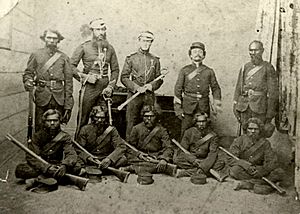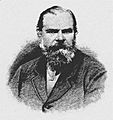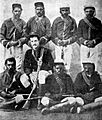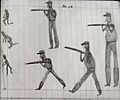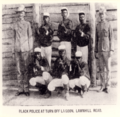Australian native police facts for kids
Australian native police units, consisting of Aboriginal troopers under the command (usually) of at least one white officer, existed in various forms in all Australian mainland colonies during the nineteenth and, in some cases, into the twentieth centuries. The Native Mounted Police utilised horses as their transportation mode in the days before motor cars, and patrolled huge geographic areas. The introduction of a Police presence helped provide law & order to areas which were already struggling with crime issues. From established base camps they patrolled vast areas to investigate law breaches, including alleged murders. Often armed with rifles, carbines and swords, they sometimes also escorted surveying groups, pastoralists and prospectors through country considered to be dangerous.
The Aboriginal men within the Native Police were routinely recruited from areas that were very distant from the locations in which they were deployed. As the troopers were Aboriginal, this benefited the colonists by minimising both the wages of the police and the potential for Aboriginal revenge attacks against white people. It also increased the efficiency of the force as the Aboriginal troopers possessed incredible tracking skills, which helped to track persons under investigation, often in poorly charted and difficult terrain. Their bush survival skills were of high importance to the police service.
The first government funded force was the Native Police Corps, established in 1837 in the Port Phillip District of the then Australian colony of New South Wales (now Victoria). From 1848 another force was organised in New South Wales, which operated mostly within the borders of the later colony of Queensland. This force, sometimes called the "Native Mounted Police Force", was initially funded by squatters, and was the largest and longest lasting of the mainland forces. Some early units were accused of riding with "light trigger fingers", and conducting extrajudicial shootings of Aboriginal people under the official euphemism of "dispersal". It existed from 1848 to about 1915, when the last Native Police camps in Queensland were closed.
Dispersal of Aboriginal people was also employed by the Native Police of other colonies and also by groups such as pastoral station workers, the colonial army and the Border Police. The government of South Australia set up a short-lived Native Police force in 1852, which was re-established in 1884 and deployed into what is now the Northern Territory. The colonial Western Australian government also initiated a formal Native Police force in 1840 under the command of John Nicol Drummond. Other privately funded native police systems were also occasionally used in Australia, such as the native constabulary organised by the Australian Agricultural Company in the 1830s. Native Police forces were also officially implemented in the Papua and New Guinea territories administered by colonial Queensland and Australian governments from 1890 until the 1970s. The Australian government also organised a native police force on Nauru during its administration of the island from 1923 until 1968.
Early prototypes of native police
The general template for native police forces in Australia was the sepoy and sowar armies of the East India Company. However, the more compact forces of the Cape Regiment in southern Africa and the Kaffir and Malay Corps in Ceylon are a closer comparison. Before the creation of the first official Native Police forces, there were some informal and privately funded examples of utilising Aboriginal men as enforcers of land claims by European settlers during European colonisation.
Establishment
In October 1837, Christian Ludolph Johannes de Villiers was appointed to command the first official Native Police troopers from their station at Nerre Nerre Warren, in spite of warnings against the use of native police from the House of Commons Select Committee on Aborigines based on the argument that ‘uncivilized men’ enlisted ‘in defence of order’ would ‘become the victims of their own zeal’. It was disbanded briefly in January 1838 but reorganised in April of the same year with their new headquarters in Jolimont where the MCG carpark is now situated. Due to funding problems, the force was again dissolved in 1839. These issues delayed reformation of the corps until Superintendent Charles La Trobe indicated he was willing to underwrite the costs in 1842. A significant factor in the restoration of the force was the successful capture of five Tasmanian aboriginal people near Westernport in 1840 by local Aboriginal men who were attached to a party of Border Police and soldiers.
Henry EP Dana was selected to command the corps in 1842. Except for a brief period where the corps was based at Merri Creek, the headquarters was at the Aboriginal Protectorate Station at Nerre Nerre Warren, near to present day Dandenong about 25 kilometres (16 mi) south-east of Melbourne. The force made use of Aboriginal men from the Wurundjeri and Bunurong tribes and was made up of 60 members, three-quarters of whom were "natives". There were two goals in such a force: to make use of the indigenous peoples' tracking abilities, as well as to assimilate the Aboriginal troopers into white society. Both La Trobe and William Thomas, Protector of Aborigines, expected that the men would give up their traditional way of life when exposed to the discipline of police work. To their disappointment, troopers continued to participate in corroborees and in ritual fighting, although not in uniform.
As senior Wurundjeri elder, Billibellary's cooperation for the proposal was important for its success, and after deliberation he backed the initiative and even proposed himself for enlistment. He donned the uniform and enjoyed the status of parading through the camp, but was careful to avoid active duty as a policeman to avoid a conflict of interest between his duties as a Wurundjeri ngurungaeta.
After about a year Billibellary resigned from the Native Police Corps when he found that it was to be used to capture and kill other natives. He did his best from then on to undermine the corps and as a result many native troopers deserted and few remained longer than three or four years.
Duties
The main duty of the Native Police was to be deployed to areas around the Port Phillip region where Aboriginal resistance to European colonisation was unable to be controlled by armed settlers. Once in these areas, the troopers and their officers were placed under the command of the local Commissioner for Crown Lands, who would then seek out and capture or destroy the dissident groups and individuals. In addition to Native Police, the Commissioner also had the troopers of the Border Police and NSW Mounted Police as well as armed volunteer settlers at his disposal to conduct punitive raids on Aboriginal people.
Other more minor duties of the native police included searching for missing persons, carrying messages, and escorting dignitaries through unfamiliar territory. During the goldrush era, they were also used to patrol goldfields and search for escaped prisoners. They were provided with uniforms, firearms, food rations and a rather dubious salary. However, the lure of the goldfields, poor salary and Dana's eventual death in 1852 led to the official disintegration of his Native Police Corps in January 1853.
During its existence, there were three main areas of activity of this corps: Portland Bay, Murray River, and Gippsland. Divisions of the Native Police would be deployed to these areas in the winter of each year until 1852 and spend the rest of the year mostly garrisoned at the Narre Narre Warren barracks. Winter was chosen as the period of active duty as the target Aboriginal people were more sedentary in the colder periods and therefore much easier to find.
Images for kids
-
Native Police with constables Bateman and Whiteford at Musgrave barracks around 1898
See also
- Aboriginal tracker
- First Nations Police (Ontario)
- History of Victoria
- History of Queensland
- List of massacres of Indigenous Australians
- United States Indian Police
- Victorian gold rush
- White Woman of Gippsland


